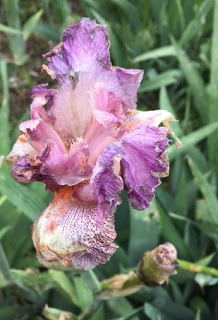 |
| 'Christopher Columbus' |
 I've briefly mentioned his presence before, but 'Christopher Columbus' has been in this garden since the summer of its founding. I purchased him in 2001 from Heirloom Roses, a mere sprig of a rose with the virtue of a striped and cheerful disposition. He rests still where he was first planted, in a southern exposure with the protection of a large 'Josee' lilac to the west and a yet taller Viburnum lentago 'Nannyberry' to the north, both of which served to protect him from the earlier hail storm that smashed the rest of my garden. One of my few roses to bloom this year with some semblance of their normal abundance, I'll simply thank him for his survival over many years and thank Provenance for his protection this year.
I've briefly mentioned his presence before, but 'Christopher Columbus' has been in this garden since the summer of its founding. I purchased him in 2001 from Heirloom Roses, a mere sprig of a rose with the virtue of a striped and cheerful disposition. He rests still where he was first planted, in a southern exposure with the protection of a large 'Josee' lilac to the west and a yet taller Viburnum lentago 'Nannyberry' to the north, both of which served to protect him from the earlier hail storm that smashed the rest of my garden. One of my few roses to bloom this year with some semblance of their normal abundance, I'll simply thank him for his survival over many years and thank Provenance for his protection this year. 'Christopher Columbus' has never topped 4 foot tall in my garden and grows almost as wide, about 3 feet in most years. The clustered, semi-double flat blooms are 2" in diameter, and I disagree with Internet sources that claim it is strongly fragrant; mine has only a very slight fragrance. He does repeat bloom, although sporadically and with less abundance over the summer. The foliage is dark green and completely blackspot and pest free in this environment. You have only to trim out the dead canes after each winter (which do seem to occur somewhat frequently even though he is cane-hardy in this marginally Zone 5 garden) to keep him looking his best. The stripes however, the pink and white stripes surrounding bright yellow stamens, are magnificent, every bloom unique and eye-catching when it first opens.
'Christopher Columbus' has never topped 4 foot tall in my garden and grows almost as wide, about 3 feet in most years. The clustered, semi-double flat blooms are 2" in diameter, and I disagree with Internet sources that claim it is strongly fragrant; mine has only a very slight fragrance. He does repeat bloom, although sporadically and with less abundance over the summer. The foliage is dark green and completely blackspot and pest free in this environment. You have only to trim out the dead canes after each winter (which do seem to occur somewhat frequently even though he is cane-hardy in this marginally Zone 5 garden) to keep him looking his best. The stripes however, the pink and white stripes surrounding bright yellow stamens, are magnificent, every bloom unique and eye-catching when it first opens. If you choose to acquire him, you must be careful for there are at least two 'Christopher Columbus'-named roses out there and both bred in the same year, 1992 of course, for the quincentenary of their more famous namesake's Atlantic crossing. One is an orange-blend hybrid tea introduced by Meilland, but my 'Christopher Columbus' is a floribunda introduced by Poulsen, also known under the aliases of Candy Cover, Dipper Hit®, Nashville™, and POUlbico. That's a lot of names for a rose bred from two unnamed seedlings. Nashville™ is its exhibition name, and it is known as Dipper Hit® within the PatioHit® Collection. With all these names you might wonder why I still call him 'Christopher Columbus', but the latter is the name I purchased him under. If you lust after his stripeness, just tell the nursery you want the striped 'Christopher Columbus'. But good luck finding him because right now he is only listed under a German nursery and even then under the 'Candy Cover' alias.
In the meantime, however, I feel only fortunate to observe 'Christopher Columbus' as it leaps into this brave new post-hail world and receives its fifteen minutes of fame. I appreciate it even as I know it is destined to fade back into my landscape until such time as it is thrust again into the forefront by a freak storm.









































